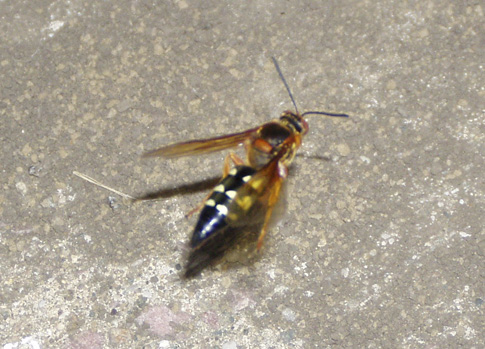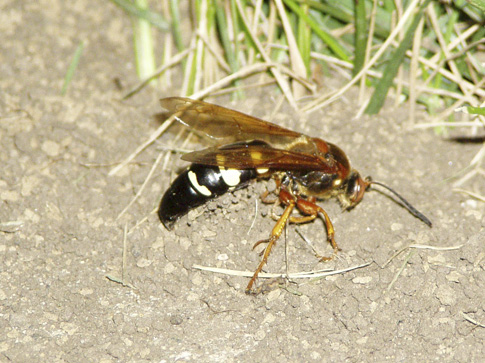For the last few summers we’ve had some scary looking bugs in our yard. Thankfully, they’re just scary looking, and nothing to really be afraid of, provided you’re not a cicada.

A female cicada killer wasp in flight, approaching a prospective nest site.
The lifecycle of the cicada killer wasp sounds like something out of a Ridley Scott movie… The female cicada killer wasp hunts down a cicada and stings it to paralyze it. When the cicada is safely immobilized, the wasp carries the cicada back to its burrow — a hole dug in loose soil. The cicada is placed in a dead-end chamber of the burrow; the female then lays a single egg (sometimes two) on the still paralyzed but very much alive cicada, and seals up the chamber. When the egg hatches, the larva gnaws through the exoskeleton of the cicada and feeds on its internal organs, saving the nervous system for last so as to maximize the length of time that the cicada remains alive. Gruesome, no?

The same female digging in the loose dirt for a new nest site.
The female cicada wasp killers are very large; up to 2 inches long. I’ve had them buzz by my head a few times and the sound is pretty unnerving if you’re not expecting it. The males are supposedly much smaller, but I can’t say that I’ve seen any.
Very scary looking, but very cool. It’s this kind of thing that makes me really question the theory of evolution. The evolution of physical body parts is only part of the equation; what about complex behaviors like this? So the larvae that just happened to leave the nervous system for last gained an evolutionary advantage over the others? And how did that “just happened” get passed on to the progeny of those lucky larvae? Nah; not buying it. I wouldn’t need to believe in an omnipotent, omniscient Creator to know that something like that doesn’t happen by chance.
God makes some cool stuff!